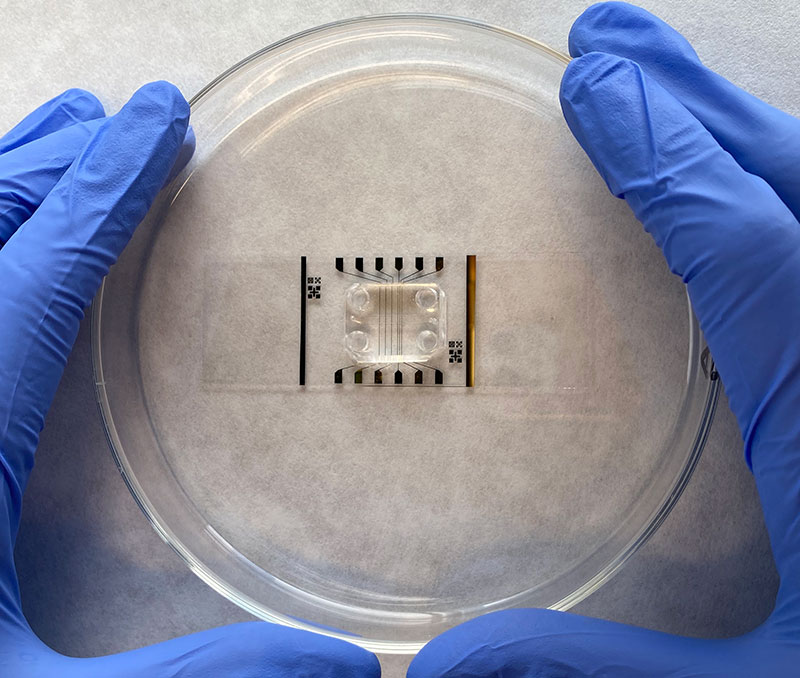A study led by the Institute of Bioengineering of Catalonia (IBEC) describes the development of an organ-on-a-chip that mimics the human blood-brain barrier. With this system, researchers can study the barrier permeability to different drugs and screen the most effective ones, avoiding animal tests. The device could also incorporate cells from patients to make a personalized study of the disease.

The blood-brain barrier has an important biological function as it protects the brain from possible toxins in the blood, supplies nutrients to brain tissues, and filters harmful compounds from the brain back into the bloodstream. However, it is also a physiological barrier that prevents most drugs from reaching the brain. This is an obstacle to the development of effective drugs against neurodegenerative diseases.
Most traditional cell culture methods that are used to study drug behavior do not adequately reproduce patients’ physiology. On the other hand, animal models behave differently from humans, are expensive, and have ethical constraints.
In this sense, the so-called organ-on-a-chip (OoC) platforms are an excellent alternative to traditional study methods since they mimic the functioning of specific human organs on a microscopic scale. These systems make it possible to screen drugs and study diseases, thus offering the possibility of avoiding animal testing faster and at a lower cost.
A recent study by the Institute of Bioengineering of Catalonia (IBEC) describes the development of an organ-on-a-chip that mimics the human blood-brain barrier. The system allows researchers to study the barrier permeability to different drugs and screen the most effective ones, avoiding animal tests.
The presented system is highly versatile and opens the door to study pathological processes on the chip. According to Dr. Anna Lagunas, IBEC researcher and coauthor of the publication, “the device could also be adapted to different types of studies involving the pathology of the human brain, as is the case of many neurodegenerative diseases, in which the integrity of the blood-brain barrier is often compromised. In addition, if patient cells were incorporated into the chip, it would allow a personalized study of the disease.”

Also, “the physical characteristics of the device make it portable, easy to use and could undergo mass production and automation of both optical and electrical readings for future industrial implementation.” Explains Dr. Mónica Mir, IBEC researcher and professor at the Electronics and Biomedical Engineering Department in the University of Barcelona (UB) and coauthor of the study.
The work, published in the Journal of Nanobiotechnology, was led by Drs. Mònica Mir and Anna Lagunas, who are researchers in the Nanobioengineering group led by Josep Samitier. Both are members of the Networking Biomedical Research Center in Bioengineering, Biomaterials and Nanomedicine (CIBER-BBN) in Madrid. The study also had the participation of the University of Barcelona, the University of Chile, and the Advanced Center for Chronic Diseases of Chile.
How does this organ-on-a-chip work?
The device is manufactured in a microfluidic system, which allows the manipulation and control of fluids on a small scale and the analysis of small volumes samples.
It includes a three-dimensional culture of different types of cells that form an endothelial barrier structure. This barrier has the function of separating the blood from adjacent tissues, mimicking the human blood-brain barrier.
The model also incorporates a system of microelectrodes to monitor the integrity and permeability of the endothelial barrier with better performance than the current standard models.
Sujey Palma, PhD student at IBEC and first author of the study, celebrates the work done: “It is a platform with a great potential for adequately evaluating the permeability of promising new therapeutic candidates such as nanosystems. Also, such a device could allow us to study how these new systems can morphologically and physiologically affect the barrier post-administration.”
The group of Marcelo J. Kogan at the University of Chile, co-authors of the article, developed a nanometric system for the delivery of drugs which was used to test the chip. The therapeutic nanosystem is made from gold nanoparticles that facilitate the permeation of the drug through the blood-brain barrier and bind to the so-called amyloid beta fibers – molecules that form in Alzheimer’s disease – disaggregating them.
Referenced paper:
Sujey Palma-Florez, Adrián López-Canosa, Francisco Moralez-Zavala, Oscar Castaño, M.J. Kogan, Josep Samitier, Anna Lagunas & Mònica Mir. BBB-on-a-chip con micro-TEER integrado para la evaluación de permeabilidad de nanovarillas de oro multifuncionalizadas contra la enfermedad de Alzheimer. J Nanobiotechnol (2023). DOI: 10.1186/s12951-023-01798-2





